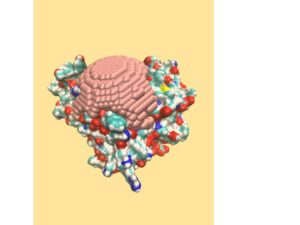This week was the turning point of my internship at UCSD where we changed from just learning how to do different analysis methods on our training proteins to creating our own analysis methods to use on the test set of systems with the tools that we learned in the first 3 week of our internship. We were put into groups of three and assigned the task of coming up with at least 3 different original analysis methods of predicting the IC50 of the 6 test set systems, which we do not already have the IC50. We are able to do this by using the 6 training systems which we do already have the IC50 of and creating a line of best fit for all of our analysis methods for which we can fit the 6 test set systems onto the trend line.
Our first method that we came up with was to simply get the center of mass of the binding site of our protein, which binds to our ligand, and then get the center of mass of the ligand itself. With these two center of masses we can measure the distance between the two and how much it fluctuates to potentially see how strongly the ligand is bound to the binding site to see if that correlates to IC50. The next method our group came up with was a bit more complicated; we decided that we would try to estimate the system entropy because entropy is directly correlated to the bond free energy of the system which is directly correlated the the IC50 of a system in the equation “DeltaG = RTlnIC50”. It is just about impossible to find the actual entropy of a system but we decided that we would try to estimate it by seeing how many water molecules starts in the binding site at the beginning of the simulation and then how many water molecules are in the binding site after the ligand is bound because theoretically the bigger the bulk solute around the protein the more entropy it will have so the less binding free energy so the lower IC50 it will have. And the third method we came up with is the simplest of the three methods which is basically taking the 2D structure of all of the training set system ligands and using a comparison program, compare the to the 2D structure of the ligands within the test set. And then just coming up with a rank order of the proteins assuming that if the two systems have similar structure then they will also have similar IC50s. We will be testing all these methods in the coming weeks which I am very excited about and hopeful that our methods will end up working out and will be able to provide us with some valuable information.


There are no comments published yet.